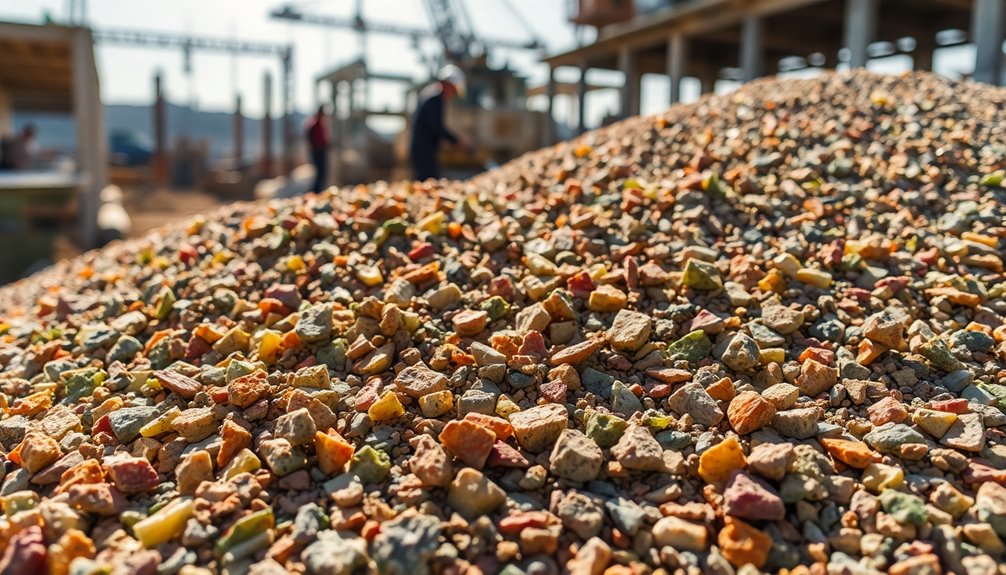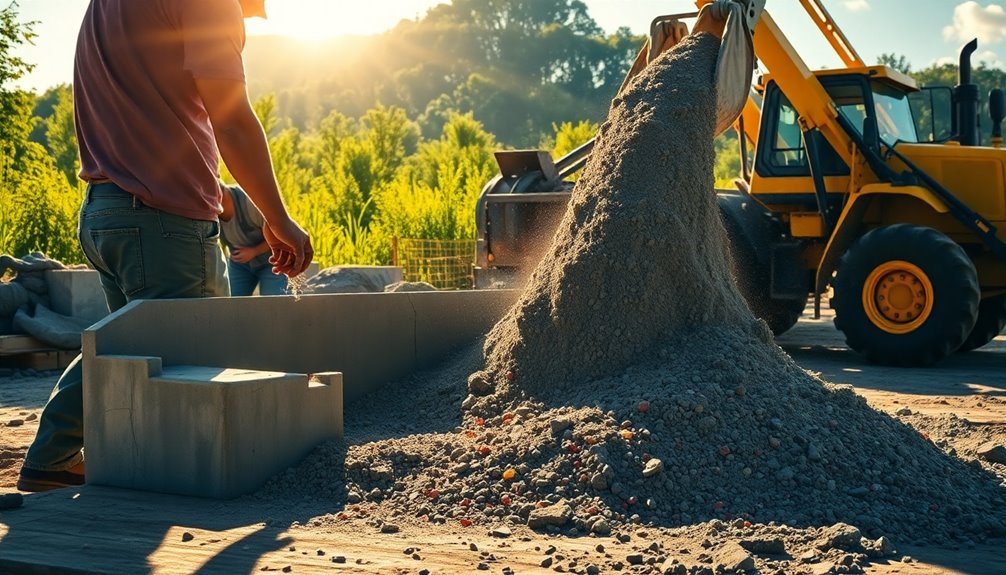Recycled cements are a game-changer for eco-friendly construction. They cut down carbon emissions while still delivering the same strength and performance as traditional options. By utilizing materials like fly ash and slag, you help preserve natural resources and reduce landfill waste. Plus, the cost-effectiveness of recycled cement means you can allocate your budget more flexibly. If you want to discover all the advantages and applications for your next project, there's more to explore.
Key Takeaways
- Recycled cement utilizes materials like fly ash and slag, significantly reducing carbon emissions without compromising strength.
- It maintains performance comparable to traditional cement, ensuring structural integrity in various applications.
- Production costs decrease due to less reliance on virgin materials, making it an economically viable option.
- Recycled cement helps divert construction waste from landfills, promoting sustainable construction practices.
- Its versatility allows for use in foundational, structural, and landscaping projects while enhancing overall sustainability.

Recycled cement is becoming a game-changer in sustainable construction, offering a host of eco-friendly benefits. By utilizing materials like fly ash and slag, you can significantly reduce your carbon footprint. Traditional cement production contributes to about 8% of global CO2 emissions, but recycled cement helps lower this figure dramatically.
You're not only preserving natural resources but also decreasing the extraction of virgin materials like limestone. Furthermore, using recycled concrete aggregate (RCA) in your projects complements the benefits of recycled cement by providing a sustainable alternative to traditional aggregates.
Preserving natural resources while reducing the need for virgin materials like limestone is a key benefit of recycled cement.
One of the most appealing aspects of recycled cement is its cost-effectiveness. You'll find that production costs drop thanks to the reduced need for raw materials and energy. This means you can allocate your budget more flexibly, allowing for more investment in other parts of your project.
Plus, as demand for sustainable materials grows, you'll find recycled cement increasingly sought after in the market.
The environmental impact of using recycled cement is significant. It diverts construction waste from landfills and minimizes energy use in production. By engaging in this type of construction, you're actively contributing to the development of more sustainable urban environments.
The process involves crushing existing concrete and even using thermal activation to restore its properties. This means you're not sacrificing strength; recycled cement maintains performance comparable to traditional options.
Additionally, recycled cement supports a circular economy by promoting the reuse of materials. You'll be participating in a system that reduces waste while creating job opportunities in recycling and construction.
It's a win-win for you and the environment. The versatility of recycled cement allows for various applications, whether in foundational materials, landscaping features, or structural integrity.
Incorporating recycled cement into your projects not only enhances their sustainability but also proves that eco-friendliness doesn't compromise power. You're making a smart choice that benefits both your budget and the planet, paving the way for a greener future in construction.
Frequently Asked Questions
What Materials Are Commonly Used to Make Recycled Cement?
To make recycled cement, you'll commonly use concrete waste, which significantly cuts down landfill waste.
You can also incorporate waste cement paste from demolished structures, along with industrial byproducts like fly ash and steel dust for added sustainability.
Finely ground limestone enhances strength and workability, while heating the recycled cement powder helps restore its binder properties.
These materials come together to create an eco-friendly alternative that meets performance standards.
How Does Recycled Cement Compare in Cost to Traditional Cement?
When you dive into the world of construction, you'll find that recycled cement can be a game-changer for your budget.
It's often cheaper than traditional cement, thanks to lower material sourcing and reduced transportation costs. Plus, you might snag green incentives for using it!
While the initial setup for recycling might be pricey, the long-term savings and environmental benefits can make it feel like finding gold in your backyard.
Are There Specific Certifications for Recycled Cement Products?
Yes, there are specific certifications for recycled cement products.
You can look into the CSC Certification, which recognizes sustainable concrete products, and the SGS Recycled Content Certification that verifies the use of recycled materials.
Additionally, the CSC R-Module focuses on the traceability of recycled aggregates.
These certifications enhance credibility and provide a competitive edge in the market, showcasing your commitment to sustainability and responsible sourcing in your projects.
Can Recycled Cement Be Used in All Construction Projects?
You can use recycled cement in many construction projects, but it's not suitable for every application.
Consider its performance characteristics and the specific requirements of your project. It works well for road construction, landscaping, and public infrastructure, but may need blending with traditional materials to enhance strength.
Always check local regulations and guidelines to ensure compliance.
With proper planning, you can incorporate recycled cement effectively into your construction endeavors.
What Is the Lifespan of Structures Made With Recycled Cement?
Imagine buildings standing tall like ancient trees, their roots firmly planted in the earth.
Structures made with recycled cement can last up to 100 years, matching the durability of traditional concrete.
Factors like environmental exposure, mix design, and maintenance practices play vital roles in determining their lifespan.
With proper care and optimal conditions, you'll find that these eco-friendly alternatives stand strong, proving their worth in sustainable construction for future generations.
Conclusion
In the grand tapestry of construction, recycled cements weave a vibrant thread, blending sustainability with strength. By choosing these eco-friendly alternatives, you're not just building structures; you're crafting a greener future. It's like planting seeds of change in the concrete jungle, where every pour helps reduce waste and nurture our planet. So, as you lay the foundation for tomorrow, remember: with every scoop of recycled cement, you're laying the groundwork for a sustainable legacy.









